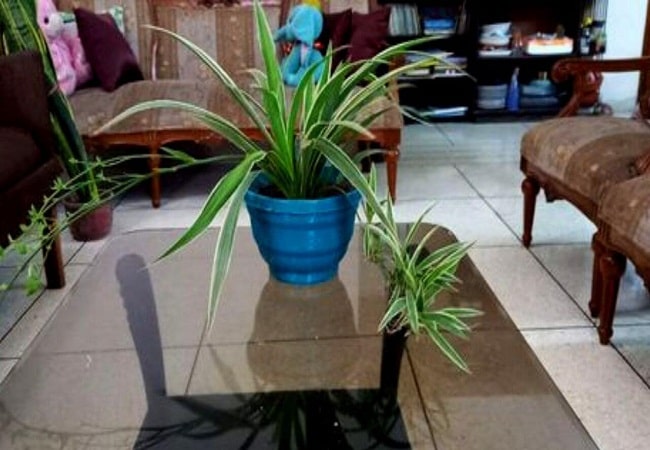Last Updated on April 19, 2023 by Md Deloar Hossain
Spider plants, called Chlorophytum comosum, are sometimes called airplane plants. Spider plants have groups of leaves that look like grass and grow in an arch. How to care of spider plants ? The baby plants on the hang-down stems give them their common names. They are one of the easiest and most flexible houseplants to grow, so they are great for people who don’t always have a green thumb.
Spider plants are easy-to-care-for houseplants that can grow in various conditions. The spider plant is a good choice if you want a plant that doesn’t need much care and can handle being ignored. How do you take care of a spider plant, though? I’ll show you how to take care of a spider plant in this blog post. Keep listening to find out more!
Quick Navigation
- 1 How To Care Of Spider Plants
- 2 The Best Care Requirements For A Spider Plant
- 2.1 Finding The Ideal Location
- 2.2 Select A Potting Medium Or Soil That Drains Properly
- 2.3 Give Off Bright, Indirect Light
- 2.4 Adjust Temperature And Humidity
- 2.5 Providing Of Basic Care
- 2.6 Water Your Spider Plant With Distilled Water
- 2.7 Keep Soil Moist But Not Wet
- 2.8 Fertilize Spider Plants Monthly During Spring And Summer
- 2.9 Transplant Your Spider Plant When It Outgrows Its Pot
- 2.10 Taking Care Of Common Issues
- 2.11 Use Scissors To Trim Dead Leaf Tips
- 2.12 Use Natural Insecticides Kill Spider Mites
- 2.13 Avoid Sun Exposure For Blanched Leaves
- 2.14 Clean The Leaves
- 3 Should You Cut The Spider Plant’s Babies Off?
- 4 Frequently Asked Questions
- 5 The End
How To Care Of Spider Plants
| Common Names | Spider plant, spider ivy, ribbon plant |
| Botanical Name | Chlorophytum comosum |
| Native Area | Central and Southern Africa |
| Family | Asparagaceae |
| Plant Type | Herbaceous, perennial |
| Adult Size | 1–2 ft. tall and wide |
| Sun Exposure | Do not appreciate direct, hot sunlight & like shade |
| Water | About once a week |
| Fertilizer | No specific spider plant fertilizer |
| Soil Type | Sandy loam soil, well-drained |
| Temperature | Between 50 °F (10 °C) and 80 °F (27 °C) |
| Humidity | Between 50-60%. |
| Soil pH | pH 6.1 to 6.5 |
| Bloom Time | Flowers regularly |
| Flower Color | White |
| Toxicity | Non-toxic to cats and dogs |
The Best Care Requirements For A Spider Plant
For a good reason, spider plants are one of the most popular houseplants! They’re easy to care for, tolerant of a wide range of conditions, and propagate easily. Here are a few tips to keep your spider plant looking its best.
Finding The Ideal Location
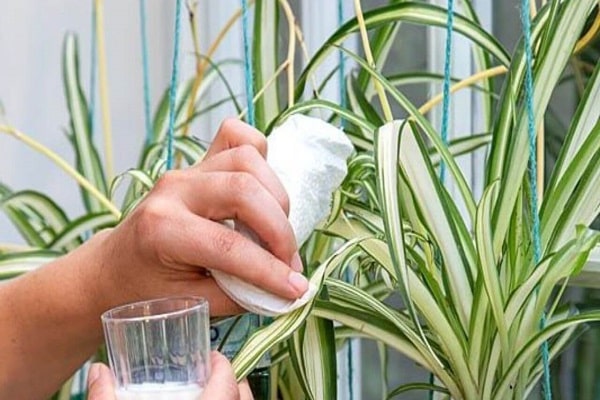
If you’re looking for a place to put your spider plant, there are a few things to keep in mind.
- First, spider plants like bright, indirect light.
- They also like to be in a spot where they can get some airflow.
- Lastly, spider plants like to be in a pot with good drainage. With these things in mind, you can provide the ideal location for your spider plant!
Select A Potting Medium Or Soil That Drains Properly
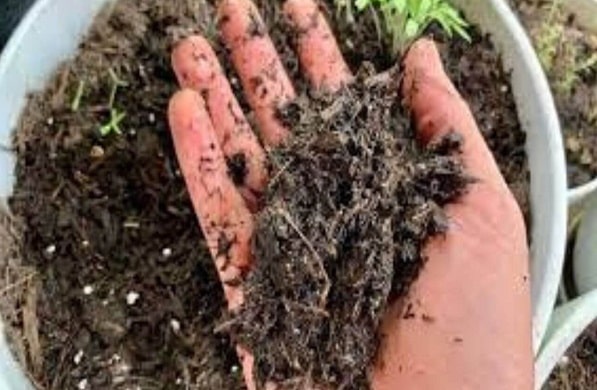
Choose soil or potting medium that drains well. If your spider plant is outside, put it in a spot with soil that drains well, like soil with sand. Choose a potting medium like vermiculite or coco coir if your spider plant is in a pot inside. Don’t worry too much about the soil because spider plants can grow everywhere.
Give Off Bright, Indirect Light

From the side, shine a bright light. Spider plants don’t need a lot of sunlight, so they do well in places like bathrooms and bedrooms. They also do well on windowsills, but you should keep them about 12 inches away from south-facing windows in the spring and summer. Please keep in mind that they will also do well in a window facing north. Plants outside should be in light to heavy shade during the day. A spider plant can get burned if it gets too much direct sunlight, so indirect is better.
Adjust Temperature And Humidity
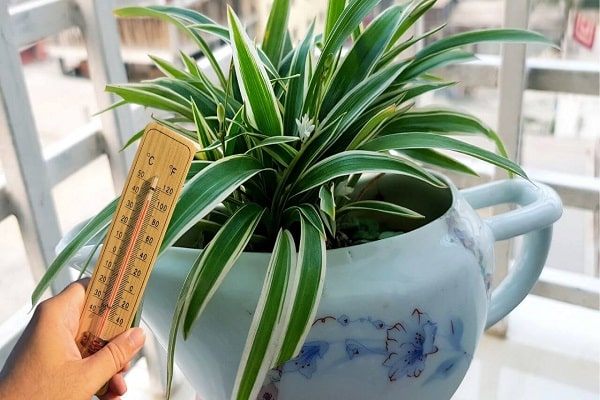
It would help if you kept the temperature and humidity steady and moderate. If you live where the weather changes a lot or gets very hot or cold, your spider plants will do better inside. They do best when the temperature is between 50 °F (10 °C) and 80 °F (27 °C). They can’t survive in places outside where it’s freezing or very hot. To make the air more humid, place a humidifier in the same room as your spider plant. The ideal humidity level for any spider plant is between 50-60%.
Providing Of Basic Care
A spider plant is a great plant in your home because it is very easy to take care of. Here are some tips on how to providing of basic care for your spider plant:
Water Your Spider Plant With Distilled Water
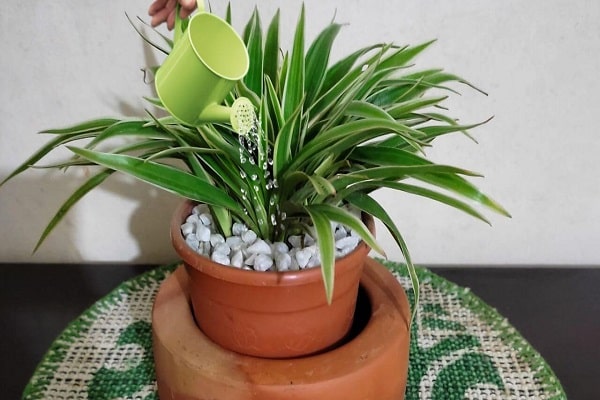
Water your spider plant with water that has been distilled or cleaned. Fluoride in tap water can hurt some plants, like spider plants. Use distilled or purified water instead of tap water because tap water leaves behind other minerals that can build up and kill your plant. You should keep the water at room temperature because shocking your plants with cold or hot water can weaken them.
Keep Soil Moist But Not Wet
Don’t let the soil get too wet. Put your finger gently into the soil to check if it is dry. If the top inch or so of soil on your spider plant is dry, it’s time to water it. During the first year, moderate or watering once a week should be enough to keep the soil moist but not too wet. You don’t have to water the plant every day after the first year. If your spider plant is in a pot, empty the drainage trays of any extra water immediately.
Fertilize Spider Plants Monthly During Spring And Summer
During the spring and summer, feed spider plants once or twice a month. You Use a general liquid fertilizer to feed your spider plants when growing. Granular fertilizers will not work as well as liquid fertilizers. Follow the instructions on the fertilizer to figure out how much of the solution to put on the soil around the plant’s base. Don’t feed spider plants in the winter if they get too big for their pots.
Transplant Your Spider Plant When It Outgrows Its Pot
When your spider plant grows too big for its pot, you should move it. If the roots of your spider plant start to grow through the drainage holes, you must repot it into a larger pot in the month of spring. Make sure to use fresh potting soil and choose a pot with holes, so the plant doesn’t get too wet.
Taking Care Of Common Issues
Some people with spider plants may not know how to care for them the best way. A spider plant can have a few common issues, but don’t worry; they’re all easy to fix!
Use Scissors To Trim Dead Leaf Tips
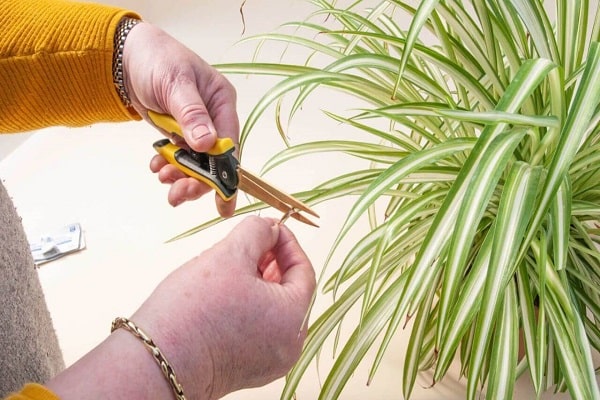
Use scissors to cut off any dead leaf tips or leaves. If you see brown or dead leaves or the tips of leaves, you should take them off. Use scissors to cut off the leaf tip or leaf so that the plant’s energy can go toward growing healthy leaves. Make sure you give your spider plants distilled or purified water because brown leaf tips could mean there are too many minerals in the soil or potting medium.
Use Natural Insecticides Kill Spider Mites

Natural insecticides you can use to get rid of spider mites. Spider mites are seen when the leaves get dull and gray and when there are web-like substances on the undersides of the leaves. To get rid of spider mites, spray the plant with a natural insecticide like neem oil. You can find neem oil at a garden store near you.
Avoid Sun Exposure For Blanched Leaves
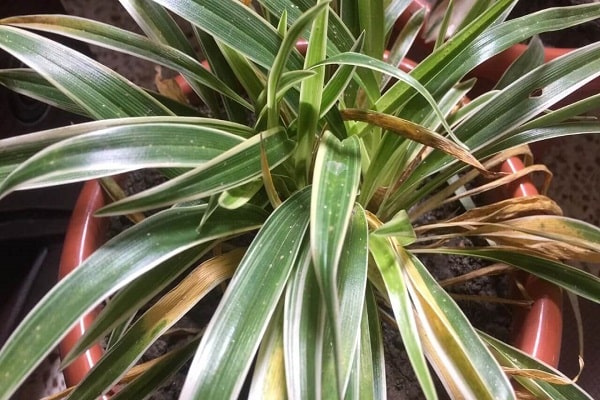
Leaves that have turned white can heal by getting less sun. Leaves and faded or whitened stem show that the plant has had too much sun. If your spider plant is outside, move it to a place with more shade or put a tall plant near it to block the sun. If you have a spider plant inside, move it away from the windows, so it gets indirect sunlight instead of direct sunlight.
Clean The Leaves
You should water a spider plant often and lightly mist its leaves to make the air more humid, which is good for the plant. It’s a good time to look at the plant’s leaves for dust, dirt, and bugs.
To maintain their cleanliness, dust the leaves with a delicate microfiber cloth, ensuring all surfaces. Debris removal will be facilitated by dampening your cloth with a small amount of water.
Should You Cut The Spider Plant’s Babies Off?

You can make more plants from a plant that has grown too big, so you don’t have to wait for it to double in size. When the days get longer, the flowers will turn into tiny spider plants called “spiderettes” that are easy to grow into new plants.
- The best way is to leave the spiderette attached to the mother plant but put it on a new pot of soil so that the nodules and tiny roots on the bottom of the plantlet are touching the soil. Keep the new soil moist, and when the spiderette has grown roots, cut the stem between the new and old plants.
- You can also cut off and root spiderettes. If you see spiderettes on a plant at a business or a friend’s house, asking if you can take a baby plantlet is a great way to grow your home jungle.
- They can grow roots in either dirt or water. They will grow roots faster in water, but plants grown roots in water can sometimes have trouble adjusting to the soil, especially if they have been in the water for a long time.
- You can root spiderettes and plant them in the same pot as the mother plant to make it fuller, even if you don’t want more plants.
Frequently Asked Questions
How To Care For A Spider Plant In The Winter?
Spider plants (Chlorophytum comosum) are one of the most popular houseplants because they are relatively easy to care for and make a great addition to any home. Most spider plants need little care in the winter, but there are a few things you should be aware of if your plant is hibernating through the cold months.
- Ensure you keep your spider plant watered during the winter, especially if it is sitting in a pot or container. However, don’t overwater as this can cause roots rot or other problems. Give your plant a light misting every day or so if necessary. If your spider plant is growing in soil, make sure it is well mulched around the roots to keep them warm and dry during the cold months.
- Spider plants typically do not require any special lighting in the winter. Still, if yours does not get enough sunlight during the day, you may want to supplement its lighting with artificial light at night. If you live in an area that experiences significant cold weather year-round, consider bringing your spider plant inside before the Christmas season so that it doesn’t endure too much cold weather at once.
- If your spider plant does not look healthy or is starting to show signs of age, it may be time to repot it into a new container. Spider plants are tough little plants and can usually take a bit of abuse before they start showing signs of wear. Still, notice any significant changes in how your plant looks or behaves. It may be time to repot it into a new container.
How To Care For Spider Plant Indoor?
Spider plants, or Chlorophytum comosum, are among the most popular houseplants because of their wide array of colors and interesting leaf shapes. Like other houseplants, spider plants need a good amount of light and water to stay healthy. However, they also need special care to avoid spider mites and other pests that can damage their leaves. Here are some tips on how to care for spider plants:
- Space Spider Plants Properly: Spider plants grow quickly, so make sure they have enough space to grow. They typically do well in a location with at least 18-24 inches of floor space, but they may need extra room if they get large.
- Give Them Enough Light: Spider plants need bright light to grow properly. Most indoor lights work well for them, but you can also give them a sunny window if you have one. Make sure the light is direct so it doesn’t burn the leaves.
- Water Spider Plants Regularly: Spider plants like moist soil, so ensure you water them regularly. A good rule of thumb is to water them once a week during the summer and once a month during the winter.
- Avoid Spider Mites: One of the biggest problems with spider plants is spider mites. These tiny creatures love to feed on the leaves of spider plants and can quickly damage them. To avoid this problem, keep your plant clean, including removing dead leaves, and use good insecticidal soap on any potential mite colonies.
- Feed Spider Plants: As with any plant, spider plants need nutrients to grow. If you’re unsure what to give them, try a general fertilizer or liquid plant food.
How Much Sun Does A Spider Plant Need?
The amount of sunlight a spider needs to survive depends on the species and location. Generally, They are low-light houseplants and grow best with 3-4 hours of indirect sunlight daily. High-light areas, such as beaches or deserts, may need more sunlight. Spiders living in dark places, such as inside homes or under rocks, may not need sunlight.
Is It Better To Water Spider Plants From The Top Or Bottom?
Watering spider plants from the top or bottom will depend on the shape and construction of the pot. For example, if the pot has a drainage hole in the bottom, water should be let out into the pot through this hole and then drained back into the garden. If the pot doesn’t have a drainage hole, water should be poured slowly and steadily onto the roots of the plant until it rises to the top of the pot.
Does Spider Plants Like Tap Water?
Spider plants are sensitive to chlorine and other chemicals that are added to tap water, so it’s best to use rainwater or water that has been filtered. If you only have tap water, let it sit overnight in the watering can so the chemicals can spread out.
What Does An Overwatered Spider Plant Look Like?
Overwatering plants can lead to excess water in the plant’s cells, which can cause the plant to become waterlogged and listless. Overwatering of spider plants is typically seen as a result of failing to properly drainage your plants or overwatering due to poor watering practices. Overwatered Spider plants will often have yellowed leaves and soft, mushy growth.
The End
There are a few things you can do to care for your spider plants: water them regularly, feed them monthly if desired, provide some sunlight, and be sure to remove any uneaten flowers or leaves. Always use caution when handling these plants – they are sensitive to touch and can bite if mishandled. Thank you for reading!

I’m Md. Mahfuz Anam always enjoys taking care of plants and gardening. I find it therapeutic and a great way to relax. I have also always been interested in learning about different types of plants and how to care for them.

